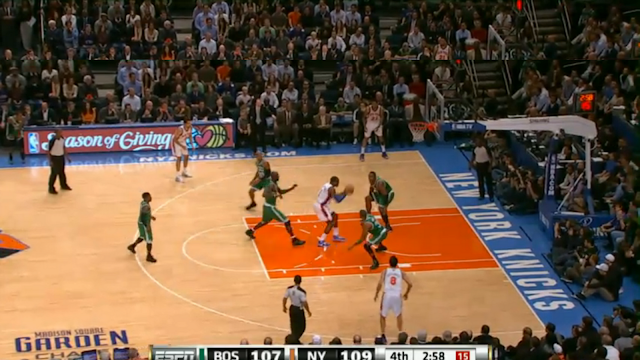After the dunk, 19,763 fans erupt in unison to express their delight. Dan Shulman says, "Stoudemire. His play is speaking volumes again tonight." The referees watch unflinchingly -- they don't begin any motions to indicate that they might make a call. And I am sitting at home wondering how Stoudemire got away with a move that looked frightfully similar to a child playing hopscotch on the numbered blacktop of an elementary school. Keep in mind as you watch the full motion clip that their are no dribbles by Stoudemire in this move to the basket. He goes from top of the free-throw circle to a dunk without a single dribble.
You could also throw in that Nate Robinson does a poor job defending the pick-and-roll, playing behind the initial screen, and then stepping up to take Felton. Poor Garnett has already stepped in to help with Felton, and he now has no chance to get back to Stoudemire.
From the NBA's rules for traveling:
A player who receives the ball while he is progressing must release the ball to start his dribble before his second step. The first step occurs when a foot, or both feet, touch the floor after gaining control of the ball. The second step occurs after the first step when the other foot touches the floor, or both feet touch the floor simultaneously.
A player who lands with one foot first may only pivot using that foot. A progressing player who jumps off one foot on the first step may land with both feet simultaneously for the second step. In this situation, the player may not pivot with either foot and if one or both feet leave the floor the ball must be released before either returns to the floor.Picture 1 (Receiving the pass - above foul line): Amar'e gathers the ball. The breakdown here is in split-second fragments, so you might argue that he doesn't quite have it gathered in yet. Both feet are on the floor.
Picture 2 (Step One - a few inches short of the foul line): Since the Stoudemire's left hand was the one bringing the ball to his body, Amar'e clearly now has possession, since his right hand has closed on it at this point. His right foot is down, but his left foot has come up. Since "the first step occurs when a foot, or both feet, touch the floor after gaining control of the ball", we need to call the placement of his right foot as 'step one'.
Picture 3 (Both feet elevated - at the foul line)
From the previous position, where Amar'e had the ball in his grasp with right foot planted, he does a little left-foot-over-right motion in which both feet are momentarily elevated.

Picture 4 (Step Two - just inside foul line)
Here we have Amar'e setting down his left foot on or just barely inside the foul line. This step is his second. Remember, there are no hidden dribbles between stills -- there are no dribbles whatsoever during the entirety of Stoudemire's possession of the ball.
Picture 5 (Step Three - to the dotted line)
Now we have Amar'e about to plant his right foot on the dotted line as he starts to plan his move between Glen Davis and Paul Pierce.
Picture 6 (Step Four - between the circles)
In preparation for takeoff, Stoudemire plants his left foot between the circles. While he will soon elevate from two feet, this move is not any type of jump-stop because he doesn't land on two feet beforehand.
Picture 7 - (Taking off for the dunk)
The best part of Amar'e's move (that possessive phrase looks like heck with two apostrophes) is that he masks the travel with an amazing feat of athleticism. While gliding at a rather rhythmic, but moderate pace, he takes off with his back foot on the dotted circle and throws down the dunk between two defenders. Davis and Pierce never create any real threat to stopping this play.
By my count, I see four steps in this move to the basket -- right foot/left foot/another right/another left. It seems reasonable to dispute the first right foot. Did he have possession when he touched that foot down? I think he did, which is why I was disheartened by the lack of attention given to this travel. But even if we discount that first step, there are three distinct steps with no jump stops here. At the very least, he goes left foot, right foot, left foot. Travel.







No comments:
Post a Comment